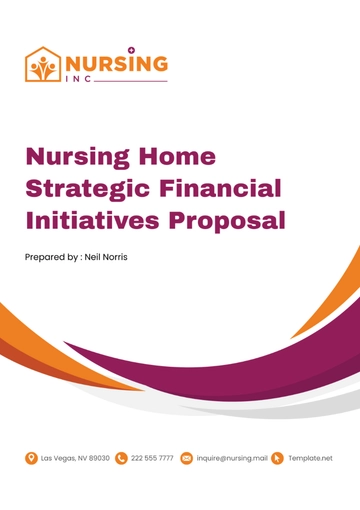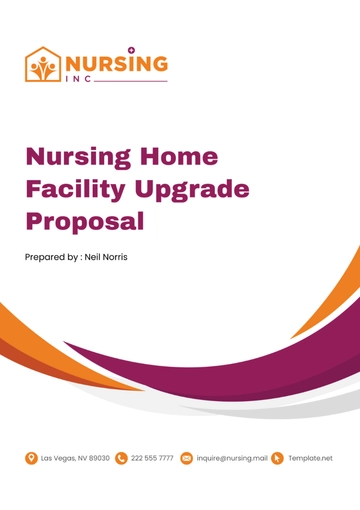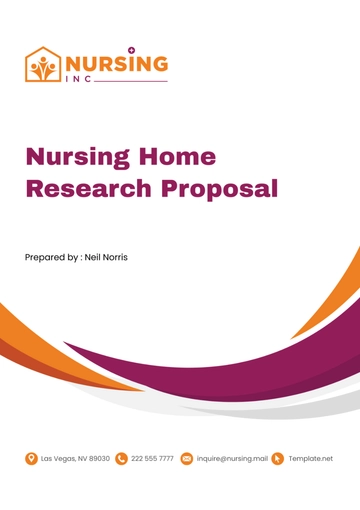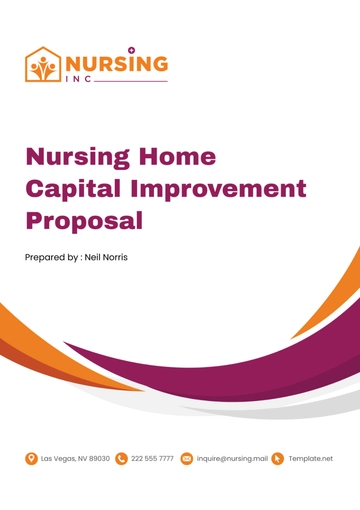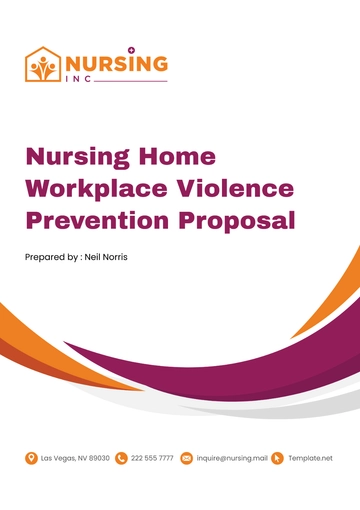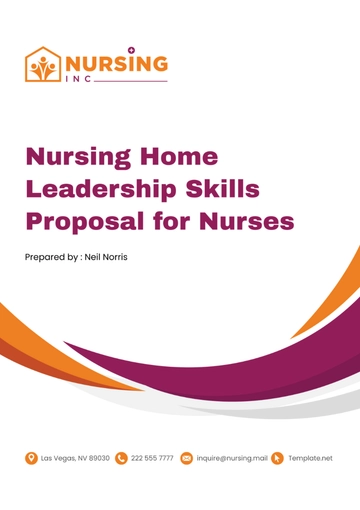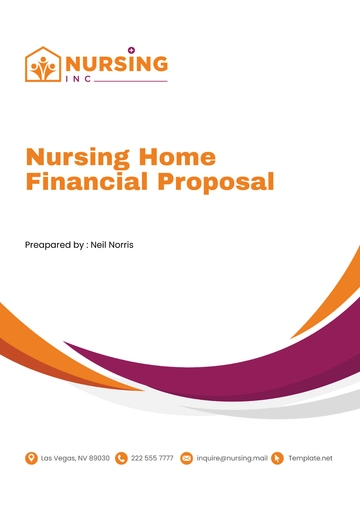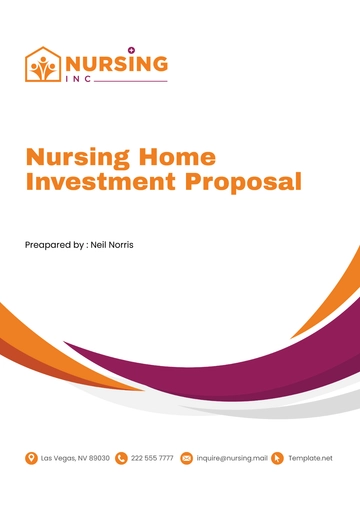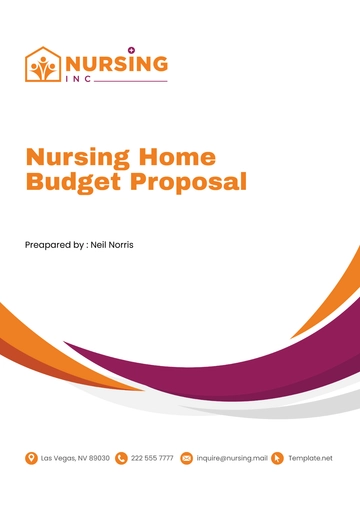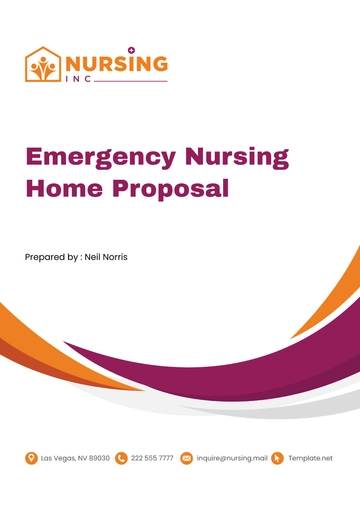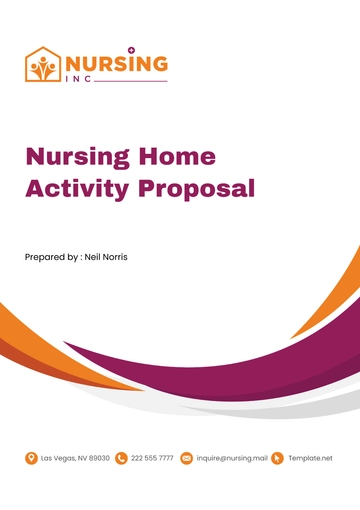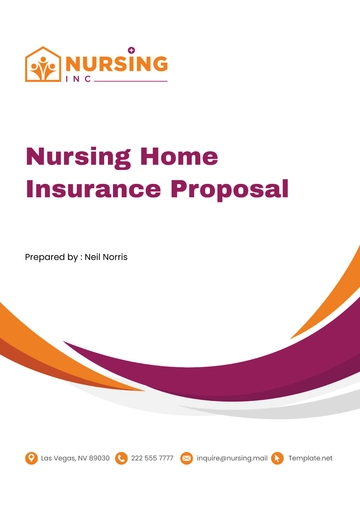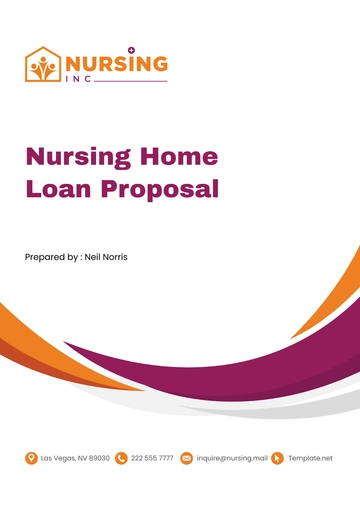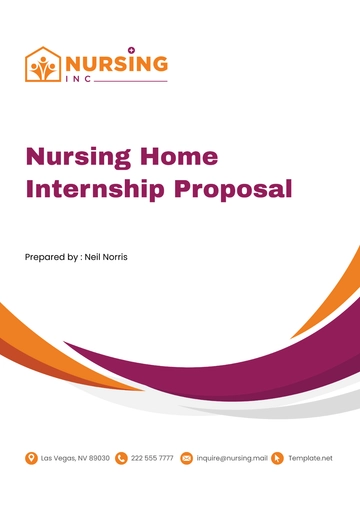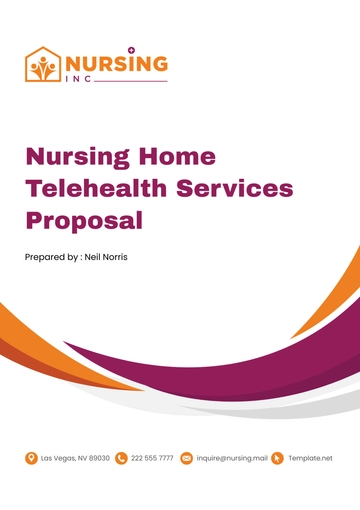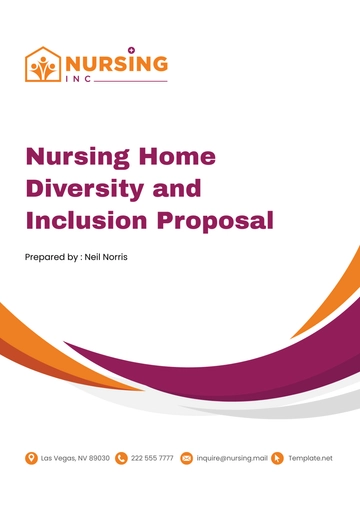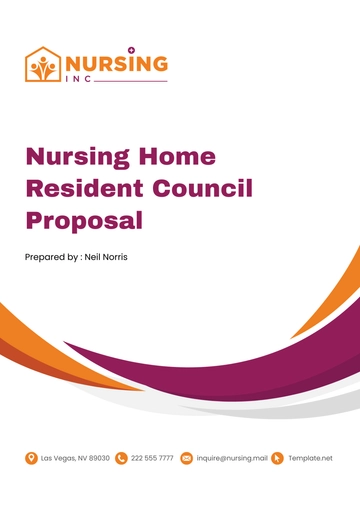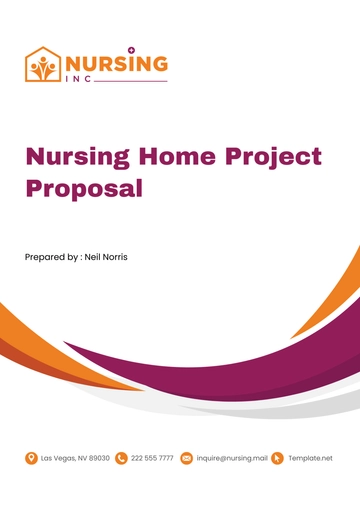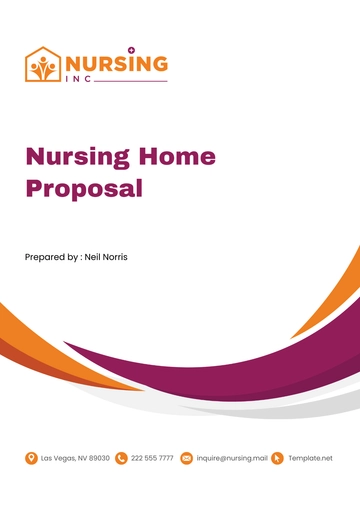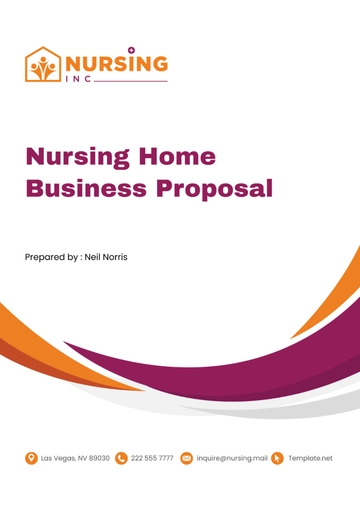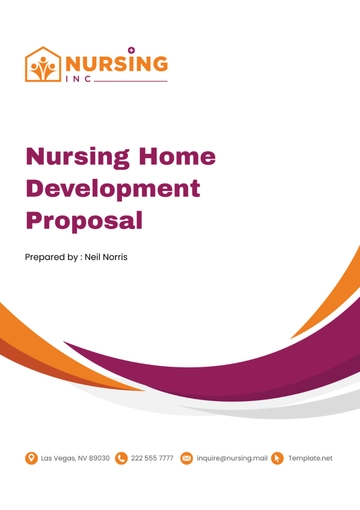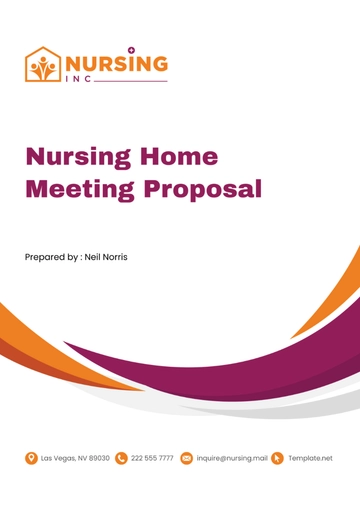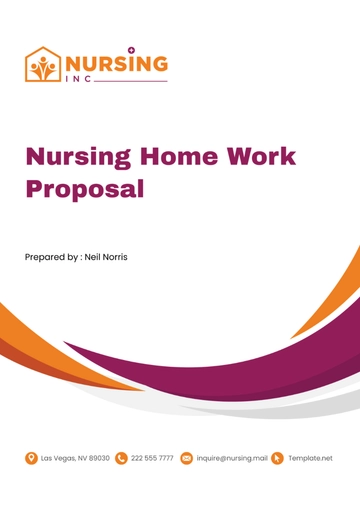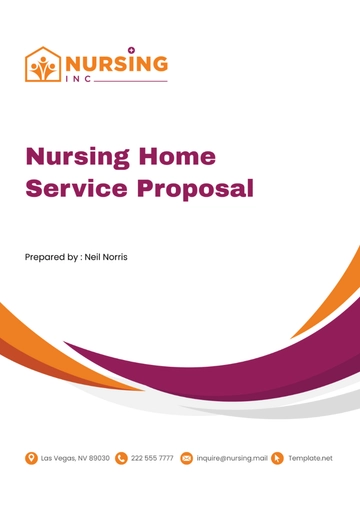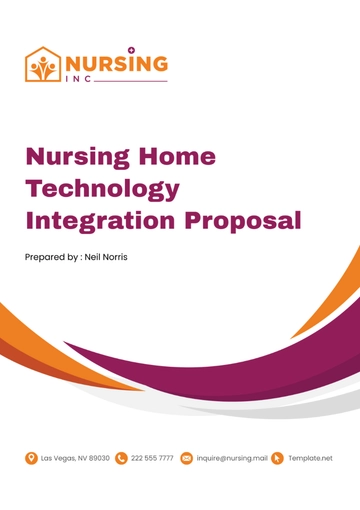Free Nursing Home Research Proposal
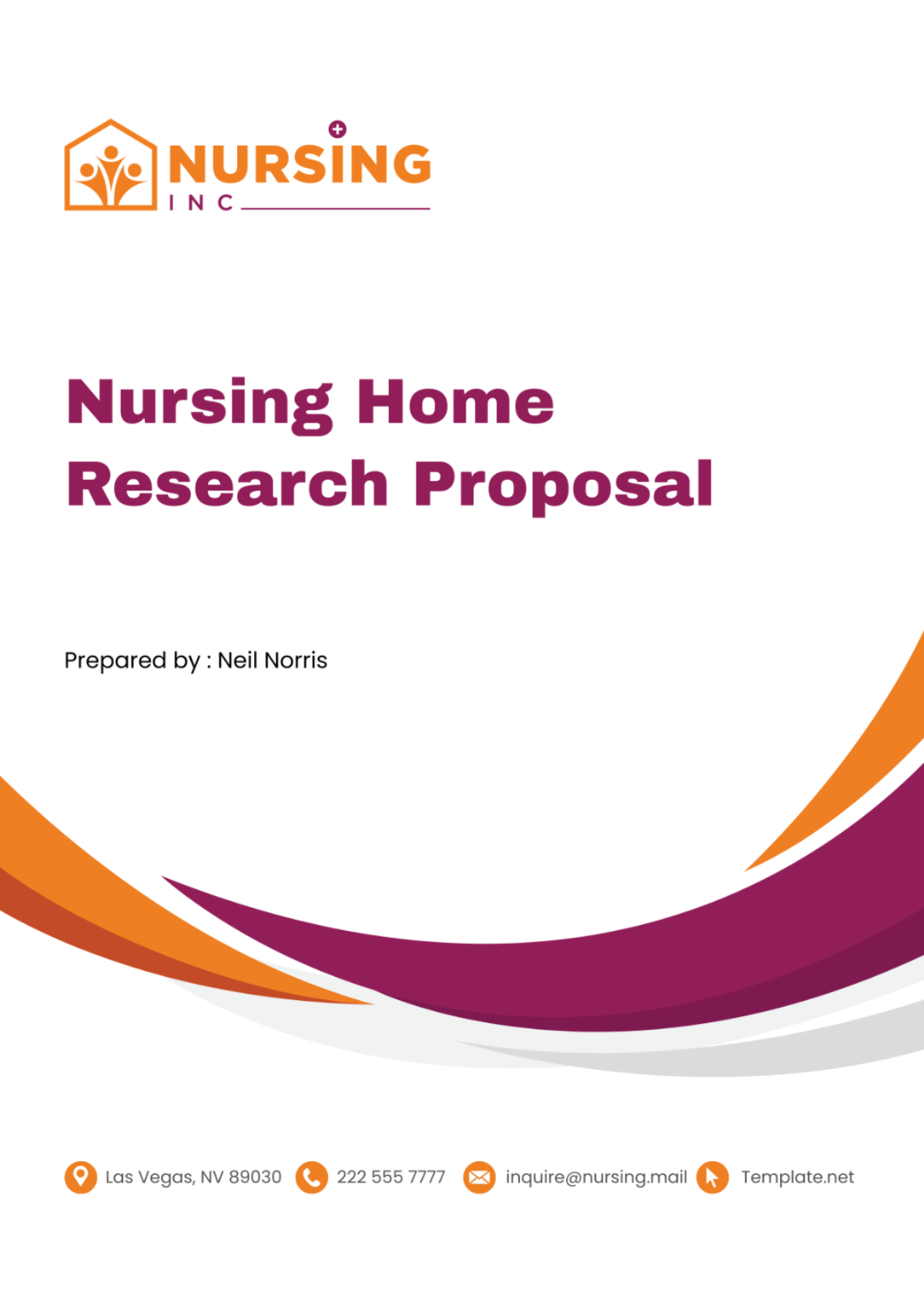
I. Executive Summary
This proposal advocates for a transformative research initiative designed to revolutionize care standards in nursing homes through the integration of state-of-the-art healthcare technologies and specialized staff training programs. Our primary objectives are to significantly enhance resident satisfaction by providing personalized, efficient care, improve staff performance and morale through advanced training techniques, and reduce operational costs through innovative practices. This initiative will serve as a scalable model, promising substantial improvements in care quality that can be replicated across the nursing home industry.
By implementing this research, we plan to directly address the challenges faced by nursing home facilities in delivering high-quality care in an economically sustainable manner. The adoption of advanced technological solutions and the development of a highly skilled workforce are poised to improve the quality of life for residents while streamlining operational processes. This approach not only benefits the residents and staff but also sets a new standard for care that influences the broader healthcare system.
Our goal is to create a benchmark in elderly care that exemplifies the effectiveness of combining technology with compassionate care. Through rigorous evaluation and continuous improvement, this research aims to provide evidence-based practices that will inform policy-making and operational strategies in nursing homes nationwide. We are committed to pioneering a future where nursing home residents receive the highest standard of care, supported by the latest innovations in healthcare technology and professional training.
II. Objectives
The primary objectives of our proposal are aimed at fundamentally enhancing the quality of care in nursing homes through technological innovation and comprehensive staff training. We plan to implement a pilot program with smart health monitoring devices, evaluate the effects of targeted training on staff and patient outcomes, and assess the cost-effectiveness of these advanced care technologies in daily operations.
Objective 1: Develop and Implement a Pilot Program Using Smart Health Monitoring Devices to Enhance Resident Care
Our first objective is to launch a pilot program that incorporates smart health monitoring devices into daily care routines. These devices will continuously track vital signs, mobility, and overall health metrics, enabling real-time adjustments to care plans. The goal is to increase the accuracy of health assessments, reduce response times in emergencies, and provide a more personalized care experience for residents. This initiative will also involve training staff on the utilization and interpretation of data from these technologies to ensure they are leveraged to their full potential.
Objective 2: Evaluate the Impact of Targeted Staff Training on Patient Outcomes and Job Satisfaction
The second objective focuses on the development and implementation of a comprehensive training program for nursing home staff. This training will be tailored to enhance their skills in using new technologies, improve their understanding of patient care standards, and strengthen communication and interpersonal skills. We will measure the success of this training by evaluating improvements in patient outcomes, such as increased comfort levels and reduced incident rates, as well as staff job satisfaction and retention rates. This objective underlines our commitment to fostering a skilled and content workforce that can deliver exceptional care.
Objective 3: Assess the Cost-Effectiveness of Advanced Care Technologies in Daily Nursing Home Operations
Our third objective seeks to conduct a thorough analysis of the financial implications of integrating advanced care technologies within our operations. This assessment will compare the initial investment and ongoing operational costs against the efficiencies gained, potential reductions in incident and liability costs, and improvements in patient care quality. We aim to demonstrate that these technologies are not only a viable investment due to their positive impact on care quality but also contribute to significant long-term savings. This objective will help justify further investment in innovative technologies and promote a sustainable model for high-quality, cost-effective elderly care.
III. Methodology
The methodology for our research is structured around a mixed-methods approach, ensuring a comprehensive analysis of the impact of technological and training interventions in nursing homes. Below is a detailed table outlining each component of our methodology:
Methodology Component | Description | Tools/Techniques | Expected Outcomes |
|---|---|---|---|
Quantitative Data Collection | Collect numerical data to measure changes in care quality, staff efficiency, and resident health outcomes. | Surveys, Smart Device Data Logging | Statistical data demonstrating the effectiveness and impact of technology integration. |
Qualitative Data Collection | Gather subjective data to understand personal experiences and satisfaction levels from both staff and residents. | Interviews, Focus Groups | Rich, detailed insights into the user experience and satisfaction with care improvements. |
Baseline Data Gathering | Establish a starting point for comparing pre- and post-intervention metrics to assess the direct impact of changes. | Health Monitoring Reports, Staff Feedback Forms | Baseline data to measure improvement against, providing a clear before-and-after comparison. |
Continuous Monitoring | Ongoing collection and analysis of data throughout the project to monitor progress and make adjustments as needed. | Real-time Health and Operational Dashboards | Real-time data enabling immediate responses to trends or issues, optimizing the intervention effectiveness. |
Final Evaluation | Comprehensive assessment at the conclusion of the pilot to evaluate overall success and areas for improvement. | Comparative Analysis, Outcome Evaluation Reports | Conclusive evidence of project success and detailed recommendations for future initiatives. |
This methodology ensures a robust framework for accurately assessing the effectiveness of technological and training interventions from multiple perspectives, thereby providing a holistic view of their impact on nursing home operations and care quality.
IV. Scope of the Study
Our study will encompass a diverse range of nursing home facilities to ensure that our findings are comprehensive and widely applicable. Below is a detailed table outlining the scope of the study, including the characteristics of each facility and the specific focus areas to be examined:
Facility Characteristics | Facility Description | Focus Areas | Purpose of Inclusion |
|---|---|---|---|
Small-Scale Facility | A nursing home with fewer than 50 residents, located in a rural area. | Resident Care, Staff Workflow | To evaluate how innovations perform in a close-knit community with limited resources. |
Medium-Scale Facility | A suburban nursing home with 50-100 residents, featuring moderate diversity in demographics. | Technology Integration, Patient Outcomes | To analyze the impact of technology on operational efficiency and patient care in a mid-sized setting. |
Large-Scale Facility | A large urban nursing home with over 100 residents, including a wide range of ethnic and socioeconomic backgrounds. | Comprehensive Care, Staff Satisfaction | To assess scalability and the effectiveness of training programs in a complex, diverse environment. |
This multi-facility approach allows us to rigorously test the effectiveness of our interventions across different operational scales and demographic complexities, ensuring that our results can inform practices across the broader healthcare sector. The diversity of these settings provides a rich dataset for understanding the varied impacts of our technological and training innovations on improving the quality of nursing home care.
V. Timeline
The timeline for our research project is strategically divided into three distinct phases to ensure systematic implementation and comprehensive evaluation of the interventions. Below is a detailed table outlining each phase of the project along with its specific duration:
Phase | Duration | Description |
|---|---|---|
Initial Setup and Staff Training | 3 months | Focus on preparing the facilities, installing necessary technology, and training the staff on new tools and protocols. This phase sets the foundation for effective implementation of the pilot program. |
Implementation of Technology and Data Collection | 6 months | Deploy the smart health monitoring devices and begin detailed data collection on resident health metrics, staff efficiency, and operational costs. This phase is crucial for gathering real-time data to assess the impact of the technological interventions. |
Analysis, Reporting, and Recommendations | 3 months | Analyze the collected data, compile reports on findings, and formulate recommendations based on the results. This final phase is dedicated to evaluating the success of the interventions and planning for broader application or adjustments. |
This structured timeline ensures that each phase is allocated sufficient time to achieve its goals, allowing for adjustments based on interim findings. This approach not only maximizes the efficacy of the interventions but also provides clear benchmarks for progress throughout the project.
VI. Budget
The budget for our research project is meticulously planned to cover all necessary expenditures for the effective execution of each phase. Below is a detailed table that outlines the budget categories, along with the estimated costs associated with each:
Category | Estimated Cost | Details |
|---|---|---|
Personnel | $130,000 | Salaries for research staff, including project managers, data analysts, and support staff. |
Operational Costs | $6,500 | Includes utilities, maintenance of technology, and other facility-related expenses. |
Participant Costs | $2,000 | Incentives and support for residents participating in the study, such as additional health monitoring. |
Training and Workshops | $10,000 | Costs for developing and delivering training modules and workshops for the nursing home staff. |
Travel and Meetings | $4,000 | Expenses related to travel for project staff and costs for hosting meetings with stakeholders. |
Miscellaneous and Contingency | $16,350 | Set aside for unforeseen expenses and emergencies that may arise during the project. |
Total Estimated Budget | $169,850 | The comprehensive sum required to fund the project, ensuring all aspects are adequately financed. |
This budget is designed to ensure that all components of the project are fully funded, reducing the risk of interruptions due to financial constraints. It provides for both predictable expenses and unforeseen costs, ensuring the project's smooth progression through its planned timeline.
VII. Impact and Benefits
The anticipated impacts and benefits of this research are multifaceted, encompassing improvements in resident care, staff development, and financial efficiency. Below is a detailed table outlining the key impacts and benefits:
Impact Area | Benefits |
|---|---|
Quality of Life for Residents | Enhanced through the deployment of smart health monitoring devices, which allow for more personalized, attentive care and early intervention in health issues. |
Staff Development and Satisfaction | Staff will receive advanced training on new technologies and care protocols, leading to increased job satisfaction, enhanced skills, and potentially lower turnover rates. |
Operational Efficiency | The integration of advanced care technologies is expected to streamline operations, reduce manual tasks, and allow for better resource management. |
Financial Sustainability | Long-term cost savings are anticipated due to more efficient use of resources, reduced need for outsourced services, and potential decreases in medical errors and related costs. |
Scalability and Replicability | Success in the pilot facilities can lead to scaling the model to other locations, promoting widespread improvements in care across the sector. |
This comprehensive research initiative not only aims to revolutionize care within the participating nursing homes but also seeks to set a benchmark in elderly care that can influence broader industry standards and practices. By achieving these outcomes, the project will demonstrate the tangible benefits of integrating advanced technology and targeted training in enhancing the overall health care environment.
VIII. Risks and Mitigation
Addressing potential risks is crucial for the success of our research project. Below is a detailed table outlining the key risks identified along with their corresponding mitigation strategies:
Risk | Mitigation Strategy |
|---|---|
Resistance to Technology Adoption Among Staff | Implement comprehensive training programs that not only instruct on how to use the technology but also highlight the benefits and improvements in care quality. Engage staff early in the process to foster buy-in and reduce resistance. |
Unforeseen Costs | Maintain a contingency budget that accounts for approximately 10% of the total estimated budget to manage unexpected expenses effectively. Regular financial audits will be conducted to ensure budget adherence. |
Delays in the Implementation Phase | Employ phased technology rollouts and set clear, achievable milestones. Regular project reviews and adjustments will be conducted to keep the project timeline on track. Utilize agile project management techniques to adapt quickly to any changes or delays. |
These mitigation strategies are designed to proactively address the risks, ensuring the project progresses smoothly and achieves its objectives within the planned timeline and budget. By preparing for these challenges ahead of time, we can significantly reduce the likelihood of project disruptions and enhance overall project success.
IX. Supporting Documentation
The success and credibility of our research rely on thorough documentation and preparatory materials. Below is a detailed table outlining the supporting documents required for the project:
Document Type | Purpose | Details |
|---|---|---|
Project Timelines and Milestones Chart | To provide a visual representation of the project's schedule, key dates, and milestones. | This chart will map out all phases of the project, including initiation, execution, and closing stages. |
Detailed Budget Breakdown | To offer transparency and detailed insights into the allocation and management of financial resources. | A comprehensive breakdown of all budget categories and expenses, including contingencies. |
Technology and Training Curriculum Outlines | To outline the educational content and objectives for training staff on new technologies and care practices. | Detailed curriculum including modules, learning outcomes, and assessment methods. |
Preliminary Survey and Interview Templates | To standardize data collection methods that will be used to gather quantitative and qualitative data from participants. | Templates designed for consistency in data gathering, ensuring comparable and valid results. |
Institutional Review Board (IRB) Approval Documents | To ensure all research activities comply with ethical standards and regulatory requirements. | Documents demonstrating IRB review and approval, confirming that the study meets ethical guidelines. |
These documents are essential for the structured management and execution of the project, ensuring all stakeholders are informed and aligned with the project's goals and processes. Each piece of documentation is designed to support the project's transparency, accountability, and adherence to best practices in research and care provision.
This proposal presents an opportunity to pioneer improvements in nursing home care that could serve as a benchmark for health services nationwide. With careful planning, execution, and continuous evaluation, we anticipate that the project will significantly contribute to the field of geriatric care.
- 100% Customizable, free editor
- Access 1 Million+ Templates, photo’s & graphics
- Download or share as a template
- Click and replace photos, graphics, text, backgrounds
- Resize, crop, AI write & more
- Access advanced editor
Discover the power of convenience with Template.net's Nursing Home Research Proposal Template. A highly editable and customizable solution, it saves time and boosts efficiency. Developed to meet the exquisite standards of professionals, this template is uniquely editable in our AI editor tool. Improve and streamline your work process. Embrace this business-transforming tool now for a flawless, efficient proposal creation. Your success is one click away.
You may also like
- Business Proposal
- Research Proposal
- Proposal Request
- Project Proposal
- Grant Proposal
- Photography Proposal
- Job Proposal
- Budget Proposal
- Marketing Proposal
- Branding Proposal
- Advertising Proposal
- Sales Proposal
- Startup Proposal
- Event Proposal
- Creative Proposal
- Restaurant Proposal
- Blank Proposal
- One Page Proposal
- Proposal Report
- IT Proposal
- Non Profit Proposal
- Training Proposal
- Construction Proposal
- School Proposal
- Cleaning Proposal
- Contract Proposal
- HR Proposal
- Travel Agency Proposal
- Small Business Proposal
- Investment Proposal
- Bid Proposal
- Retail Business Proposal
- Sponsorship Proposal
- Academic Proposal
- Partnership Proposal
- Work Proposal
- Agency Proposal
- University Proposal
- Accounting Proposal
- Real Estate Proposal
- Hotel Proposal
- Product Proposal
- Advertising Agency Proposal
- Development Proposal
- Loan Proposal
- Website Proposal
- Nursing Home Proposal
- Financial Proposal
- Salon Proposal
- Freelancer Proposal
- Funding Proposal
- Work from Home Proposal
- Company Proposal
- Consulting Proposal
- Educational Proposal
- Construction Bid Proposal
- Interior Design Proposal
- New Product Proposal
- Sports Proposal
- Corporate Proposal
- Food Proposal
- Property Proposal
- Maintenance Proposal
- Purchase Proposal
- Rental Proposal
- Recruitment Proposal
- Social Media Proposal
- Travel Proposal
- Trip Proposal
- Software Proposal
- Conference Proposal
- Graphic Design Proposal
- Law Firm Proposal
- Medical Proposal
- Music Proposal
- Pricing Proposal
- SEO Proposal
- Strategy Proposal
- Technical Proposal
- Coaching Proposal
- Ecommerce Proposal
- Fundraising Proposal
- Landscaping Proposal
- Charity Proposal
- Contractor Proposal
- Exhibition Proposal
- Art Proposal
- Mobile Proposal
- Equipment Proposal
- Student Proposal
- Engineering Proposal
- Business Proposal
